Controlling factors of sphalerite and galena deposition in Baiyinnuo’er skarn deposit, Inner Mongolia, China
2020-09-23MAWanliYANGHeandWANGKeyong
MA Wanli, YANG He and WANG Keyong,2*
1. College of Earth Sciences, Jilin University, Changchun 130061, China;2. Key Laboratory of Mineral Resources Evaluation in Northeast Asia, Ministry of Natural Resources of China, Changchun 130061, China
Abstract: The temperature, pH, fO2 and Cl- activity have been considered to be significant physicochemical parameters which controlled sulphide mineralization. Especially, the change of pH is considered to play one of the key roles in skarn deposit because of the involvement of marble. But few scholars have evaluated the impact of each parameter on mineralization. In this study, the authors have constructed thermodynamic model, calculated the important aqueous species activities in Baiyinnuo’er deposit, and evaluated the influence of these parameters on the solubility of Pb and Zn. The results show that the logfO2 decreased from -33.834 to -39.256, pH decreased from 4.0 to 3.7 and the Cl- activity increased from 0.25 to 0.30 in the main mineralization stage. The effect of fO2 was readily ruled out because the reaction of Pb and Zn precipitation did not involve changes in the valence of the element. The decreased pH was impossible to be a mineralization factor, which was confirmed by metal solubility evaluation. The Cl- activity was also considered to be a negative factor. In fact, the dominant factor of mineralization was temperature, not the combination of various parameters as previously thought. Even in the skarn stage, the main factor to make the metal solubility >10% was also the high temperature. A significant increase in pH only occurred in the post-ore stage in response to the production of large amount of calcite.
Keywords: Inner Mongolia; Baiyinnuo’er deposit; thermodynamics
0 Introduction
Skarn deposits are the premier sources of the world’s Cu, Mo, Pb, Zn, Ag and Au. The majority of the world’s skarn deposits are generally thought to be related to magmatic-hydrothermal systems based on the evaluation of fluid inclusions in skarn and porphyry deposits (Burnham, 1979; Kwak & Tan, 1981; Bodnar, 1993; Hedenquistetal., 1998; Meinertetal., 1997; Meinert, 2003; Kamenetskyetal., 2002; Baker & Lang, 2003). In addition to traditional research methods, more and more researchers are focusing on the composition of individual fluid inclusion. The two most reliable methods to quantify the composition of single fluid inclusion are laser ablation-inductively coupled plasma-mass spectrometry (LA-ICP-MS) and proton-induced X-ray emission (PIXE) (Pettkeetal., 2012).
Recently, some researchers have applied these two methods to study skarn deposits, such as the Bismark Zn-Pb-Cu skarn (Bertellietal., 2009; Bakeretal., 2004), the El Mochito Zn-Pb-Ag skarn(Samsonetal., 2008; Williams-Johnsetal., 2010) and the Baiyinnuo’er Pb-Zn deposit (Shuetal., 2017). Most of studies used element ratios to discriminate fluid sources. Bertellietal. (2009) constructed chemical model which indicated that fluid-rock interactions together with simultaneous cooling controlled the formation of gangue and ore minerals at Bismark. The data provided by Shuetal. (2017) explained the fluid evolution and source of Baiyinnuo’er deposit. But few of them have assessed the relationships between these data and the mineralization physicochemical environment.
Detailed mineral and fluid inclusion studies in the Baiyinnuo’er deposit provide an excellent opportunity to restore the ore-forming environment and assess the factors which control the mineralization (Shuetal., 2013, 2017). In this paper, we mainly focus on the mechanism of the metal deposition. The activities of important fluid species are estimated based on the composition of single fluid inclusion (Shuetal., 2017) and the extended Debye-Huekel model (Helgesonetal., 1981). The effects of T, pH and a(Cl-) on the solubility of Pb and Zn are assessed and a distinct physicochemical condition transformation is recognized which could help to understand the mineralization process of skarn deposits.
1 Geologic background
The Baiyinnuo’er deposit is situated in the south of the Great Hinggan Range (Fig.1a), northeastern China, which lies in the easternmost part of the Central Asian Orogenic Belt (CAOB) (Fig.1b). Traditionally, the CAOB was considered to be evolved through complex closure of the Paleo-Asian Ocean from Neoproterozoic to Late Phanerozoic (Wilde, 2015), and believed to be the world’s largest site of juvenile crust formation in the Phanerozoic era (Jahn, 2004).
Based on geological surveys, paleomagnetic data and precise geochronological frameworks, the northeastern China is believed to have been influenced by two tectonic systems successively, namely the complex subductions of Paleo-Asian and the Paleo-Pacific plates. The process can be further divided into four successive stages of geotectonic evolution. An early phase of crustal accretion took place in the Neopro-terozoic to Paleozoic, which was related to the subduction of the Paleo-Asian oceanic plate (Li, 2006; Wilde, 2015). This was followed by uplift in response to the closure of the Paleo-Asian and subsequent collision in the Late Permian--Early Triassic (Zhaietal., 2018a). During Jurassic, the subduction of the Paleo-Pacific plate beneath the Eurasian continental plate resulted in the thickening of the crust (Li, 2006; Wangetal., 2006; Wuetal., 2011; Wilde & Zhou, 2015; Sunetal., 2015). Finally, in the Early Cretaceous, large-scale crustal delamination and lithospheric thinning occurred (Wuetal., 2011; Wilde & Zhou, 2015), which led to extensive crustal thinning and ‘decratonization’ (Yangetal., 2008), most likely associated, at least in part, with roll-back of the Paleo-Pacific plate (Wilde, 2015).
NE China is characterized by widespread Mesozoic volcanic and intrusive rocks (Fig.1b), consisting of I- and A-type granitoids (Xiaoetal., 2004; Wuetal., 2005, 2011), which make up >50% of the surface area in the mountainous regions (Zhaietal., 2018b). Wuetal. (2002, 2011) examined the distribution of Permian, Triassic, Early Jurassic and Late Cretaceous A-type granites within the eastern CAOB. The Late Permian rocks appear to be restric-ted to a linear zone in the Xing’an Block and are attri-buted to slab-break-off following the closure of the Paleo-Asian Ocean (Wuetal., 2002). The Early Triassic granitoids are dominantly A-types and they are sparsely distributed throughout the area, being most abundant in the Xing’an and Songliao blocks (Wuetal., 2011), and their formation is linked to post-collisional extension following the closure of the Paleo-Asian Ocean. The Late Triassic to Early Jurassic A-type granites are much more widespread and Wuetal. (2002) invoked large-scale lithospheric delamination to explain their formations. The Late Cretaceous A-types granites are locally distributed and are consi-dered to be related to lithospheric delamination associated with roll-back of the Pacific plate (Wuetal., 2011).
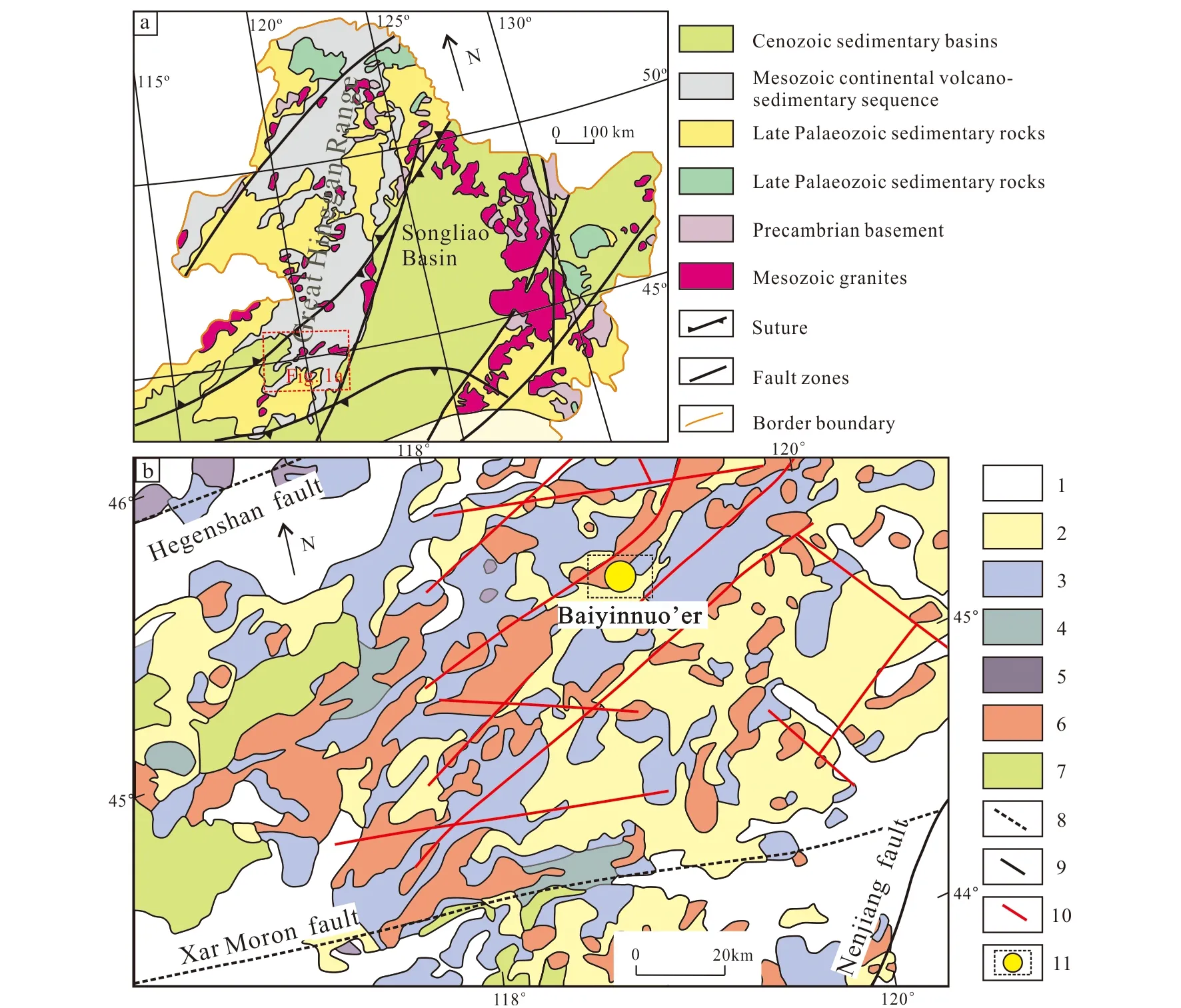
1.Cenozoic sediments; 2.Mesozoic volcano-sedimentary sequence; 3.Permian volcano-sedimentary sequence; 4.Metamorphic complex; 5.Paleozoic ophiolite; 6.Phanerozoic granitoid intrusion; 7.Cenozoic basalt; 8.inferred fault; 9.regional fault; 10.fault; 11.the study area.Fig.1 Mesozoic granites and tectonic divisions in the Great Hinggan Range, NE China (a) (after Qi et al., 2005) and Geological location of Baiyinnuo’er deposit (b) (after Ouyang et al., 2014)
However, the dominant granitoids are Jurassic in age and the bulk of them belong to I-types, and most likely evolved in a collisional environment associated with the westward advance of the Paleo-Pacific plate beneath northeast China (Wilde, 2015). Compared with other areas in the CAOB, NE China was significantly affected by Paleo-Pacific subduction, and can be considered as one of the most important metallogenic areas of the eastern Asian active continental margin during the Mesozoic (Wuetal., 2011).
The southern segment of the GHR Metallogenic Belt hosts numerous porphyry Cu-Mo, skarn Fe-Sn/Pb-Zn, and epithermal and hydrothermal vein polymetallic (Ag-Pb-Zn-Cu) deposits (Zhaietal., 2014). The southern segment of the GHR is an important Pb-Zn metallogenic belt in northern China. The ore deposits in this region are mostly related to Jurassic to Cretaceous magmatism (Zhao & Zhang, 1997; Maoetal., 2005; Chenetal., 2007; Zhaietal., 2013, 2014, 2018a).
2 Deposit geology
The Baiyinnuo’er deposit is one of the largest Zn-Pb deposits in northeastern China. It has been mined since the 1980s, with 32.74 million metric tons (Mt) of resources with averaging 5.44% of Zn, 2.02% of Pb, and 31.36 g/t of Ag (Zhangetal., 1991; Shuetal., 2013). The country rocks in the mining area consist of the Lower Permian Huanggangliang Formation sandstone, mudstone and crystalline limestone, and the Late Jurassic Manketou’ebo Formation dacite and minor interbedded tuffaceous sandstone and ignimbrite (Fig.2a). Several intrusions have been recognized at Baiyinnuo’er (Fig.2), including Permian plutons (only present in underground workings and drill cores)
(Fig.2c) with zircon U-Pb ages of 275.2±2.4 Ma and 272.9±4.4 Ma (Shuetal., 2013), Triassic granodiorite (244.5±0.9 Ma), Early Cretaceous granite (138.8±1.2 Ma) and postmineralization quartz porphyry dikes (129.2±1.4 Ma) (Jiangetal., 2011). The Early Cretaceous granite does not have potassic alteration and quartz sulfides stockworks or veins, but has extensive endoskarns composed of garnet, pyroxene and epidote close to the contact, and abundant chlorite, sericite, and kaolinite alteration farther inward where endoskarns do not develop (Shuetal., 2017). The alteration features together with the similar Pb isotope compositions between the granite and the ore minerals indicate that the Early Cretaceous granite is genetically related to mineralization.
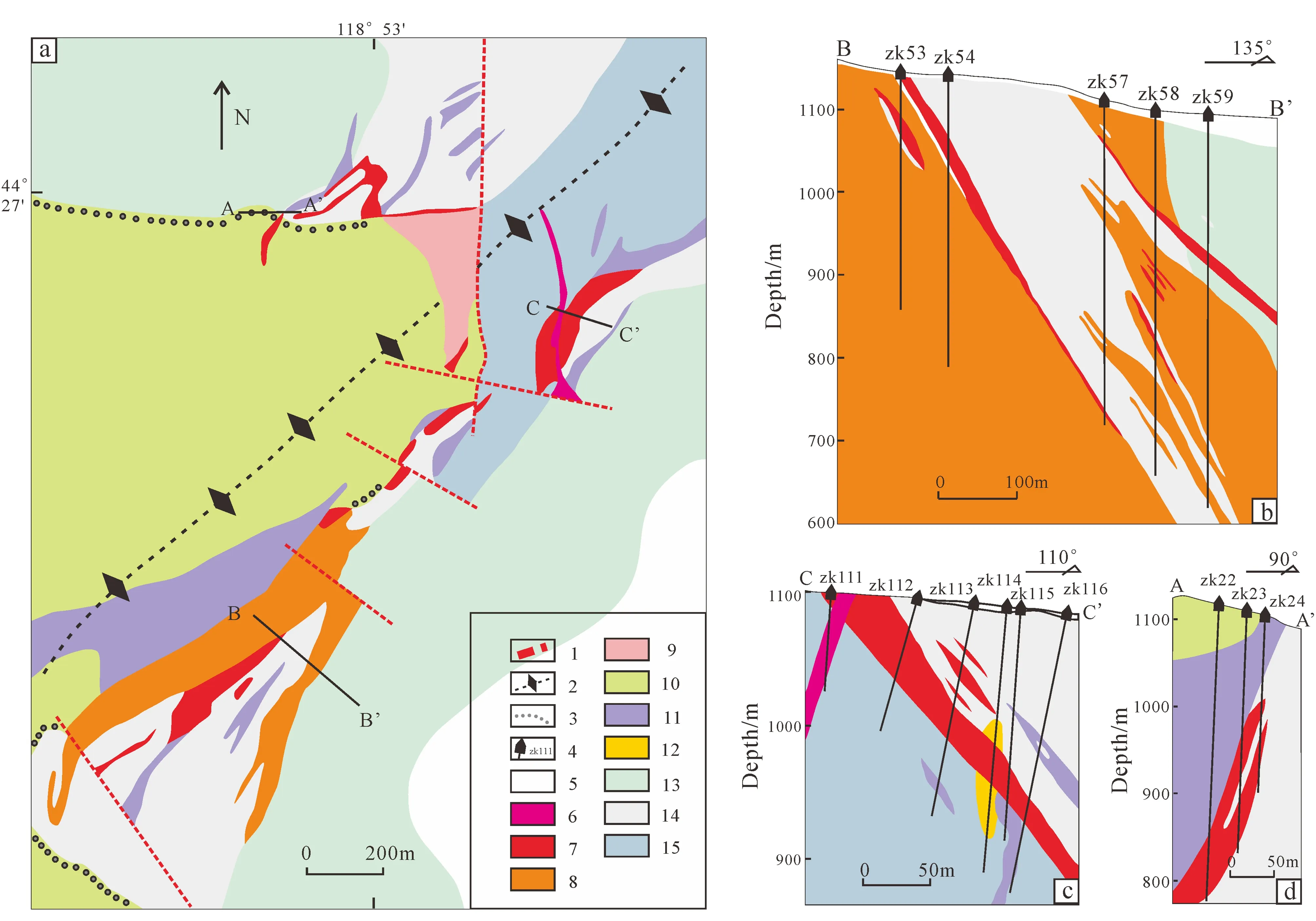
1.Fault; 2.anticline axis; 3.unconformity; 4.drill hole and number; 5.Quaternary; 6.late quartz porphyry dike; 7.skarn and orebody; 8.Early Cretaceous granite; 9.Jurassic volcanic breccias; 10.Jurassic Manketou’ebo Formation volcanic rocks; 11.Triassic granodiorite; 12.Permian intrusions; 13.Lower Permian sandstone/sandy slate; 14.Lower Permian limestone/marble; 15.Lower Permian mudstone/slate.Fig.2 Geologic map of Baiyinnuo’er skarn Zn-Pb deposit (a) and its simplified geologic cross sections (b-d) (after Shu et al., 2013)
The orebodies are mostly located in a NE-SW trending anticline. Skarn and orebodies mainly deve-lop among different units of the Huanggangliang Formation (Fig.2c) or in the contact zone between the intrusions and the Permian limestone (Fig.2b, d). The major ore minerals are sphalerite and galena, with less chalcopyrite, pyrite, and pyrrhotite, plus minor magnetite and arsenopyrite. The gangue minerals are predominantly garnet, pyroxene, quartz and calcite, with subordinate wollastonite, epidote, chlorite, and less actinolite, tremolite, vesuvianite, scapolite and fluorite (Shuetal., 2013, 2017).
3 Mineral paragenesis and fluid characteristics
Based on mineral assemblages, the mineralization sequence can be divided into three stages (Fig.3): ①pre-ore stage, ②syn-ore stage and ③post-ore stage (Shuetal., 2013, 2017). The pre-ore stage is cha-racterized by the abundant skarn minerals including garnet, pyroxene, minor wollastonite and magnetite (Shuetal., 2013). In this stage, extensive ore mi-neralization had not yet begun and only small-scale sulfides were present (Shuetal., 2017). Garnet is ge-nerally reddish to yellowish green, coarse-grained and euhedral to subhedral. Pyroxene occurs either as tiny inclusions (<50 μm) within garnet crystals or as independent aggregates, with colors ranging from light grayish green to dark green. Wollastonite commonly occurs near the marble as subhedral radiating clusters associated with clinopyroxene. Magnetite fills the interstices of, and replaces clinopyroxene. The syn-ore stage is the main mineralization stage and characterized by the extensive occurrence of sulfides, lesser quartz, minor calcite and retrograde minerals associated with mineralization. Sulfides occur as massive ores, as veins cutting prograde skarns, or are disseminated interstitially between garnet or pyroxene grains. Sulfides include sphalerite, galena, pyrrhotite, chalcopyrite, pyrite, arsenopyrite, argentite, bornite, tetrahedrite and lillianite (Shuetal., 2013, 2017; Zhangetal., 1991). Retrograde minerals include epidote, with lesser clinozoisite, tremolite, actinolite, scapolite, vesuvianite and chlorite. The post-ore stage represents the termination of mineralization and is dominated by calcite, with minor quartz, chlorite, and trace fluorite. These minerals occur as veinlets cross-cutting skarn and sulfides.
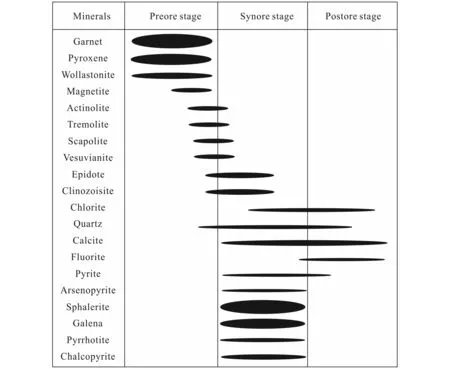
Fig.3 Schematic paragenetic sequence of Baiyinnuo’er Zn-Pb deposit (after Shu et al., 2013, 2017)
In Baiyinnuo’er deposit, detailed fluid inclusion studies have been carried out to explain the fluid properties during skarn-forming events and associated mineralization. The pre-ore fluids trapped in pyroxene had high temperatures (432℃--504℃), and high concentrations of Zn (~0.9%), Pb (~1.4%), and other elements (e.g., K, Li, As, Rb, Sr, Cs, Ba, Cl and Br).The syn-ore mineralizing fluids were coo-ler (<370℃; avg. ~330℃), and contained less Zn (~450 ppm Zn), Pb (~290 ppm Pb)(Shuetal., 2017). The post-ore fluids were much cooler (<250℃) with much lower Zn (~33 ppm), Pb (~24 ppm)(Shuetal., 2017). Although the metal contents of the pre-ore fluid were extremely high, the extensive ore mineralization had not yet begun. In pre-ore stage, the cooling was not accompanied by any decrease of metal concentrations. In contrast, a sharp drop in metal concentrations began at 370℃, even cooler temperature. Shuetal. (2017) believed that the cooling, the increase of pH and the decrease of salinity resulted in the decline of metal concentrations and mineralization. But the effects and changes of these factors on mineralization are still blurred.
4 Thermodynamic model
The physicochemical parameters controlling sulphide mineralization are normally temperature, pH,fO2and a(Cl-) (Robinson & Ohmoto, 1973; Hezakhanietal., 1999). In this study, we assessed the relative importantance of changes in these intensive parameters on mineralization at Baiyinnuo’er deposit by evaluating mineral stabilities using thermodynamic data for ore minerals, water and aqueous species from the SUPCRT92 database (Johnsonetal., 1992). Related reactions and equilibrium constants are shown in Table 1. Here, the mineral stability relationship is shown in Fig.4 to evaluate solubility of Zn and Pb, the relationship between the paragenesis of ore and gangue minerals and physicochemical environment. Relevant systems include the Fe-S-O system, Zn-S-Cl system, Pb-S-Cl system and the Ca-S-O-C system. Besides, the stability fields of alternation minerals such as K-feldspar, muscovite and clinozoisite are shown in Fig.4. The construction at different tempera-tures reflects different mineralization status of syn-ore stage.
Isothermal logfO2-pH diagrams (Fig.4a) have been constructed at 350℃ and 500 bars, which represent a relatively early mineralization stage. In contrast, Fig.4b represents a relatively late mineralization stage (300℃ and 500 bars). Due to the general para-genesis of pyrite and pyrrhotite, logfO2can be calculated to be approximately -33.834 and -39.256. This implied that the cooling process was accompanied by a decrease in oxygen fugacity in syn-ore stage. How-ever, the change in oxygen fugacity cannot affect Pb and Zn precipitation, because the reaction did not involve changes in the valence of the element. Here, when a(PbCl2) or a(ZnCl2)=10-3and 10-5, several solubility curves have been constructed. In a reduced environment, the precipitation reaction could be written as:
ZnCl2+ H2S = ZnS + 2H++ 2Cl-
(1)
PbCl2+ H2S = PbS + 2H++ 2Cl-
(2)
The effect of pH on Pb and Zn precipitation is much more significant, e.g. when the temperature is 350℃ and a(PbCl2) is 10-3, pH needs to be more than 4.8 to make the galena precipitate, and when a(PbCl2) is 10-5, the pH only needs to be more than 3.8. Although the exact value of pH is not obtained, it is certain that pH is lower than the boundary value between muscovite and clinozoisite in response to the lack of muscovite but the occurrence of clinozoisite. The relatively accurate pH and a(PbCl2) or a(ZnCl2) are discussed in details as below.

(a) logfO2-pH diagram constructed at 350℃, 500 bars, a(S)=0.1, a(C)=0.1, a(Cl-)=0.25 and a(K+)=0.05; (b) logfO2-pH diagram constructed at 300℃, 500 bars, a(S)=0.1, a(C)=0.1, a(Cl-)=0.3 and a(K+)=0.05; Total aqueous S and C activity were set to 0.1. These estimates are consistent with previous estimates in porphyry fluids (Hezakhani et al., 1999; Barnes, 1979). The activities of K+ and Cl- are consistent with the activity estimation of this study. The approximate conditions were represented by shaded areas.Fig.4 logfO2-pH diagram showing solubility and stability relationships of minerals
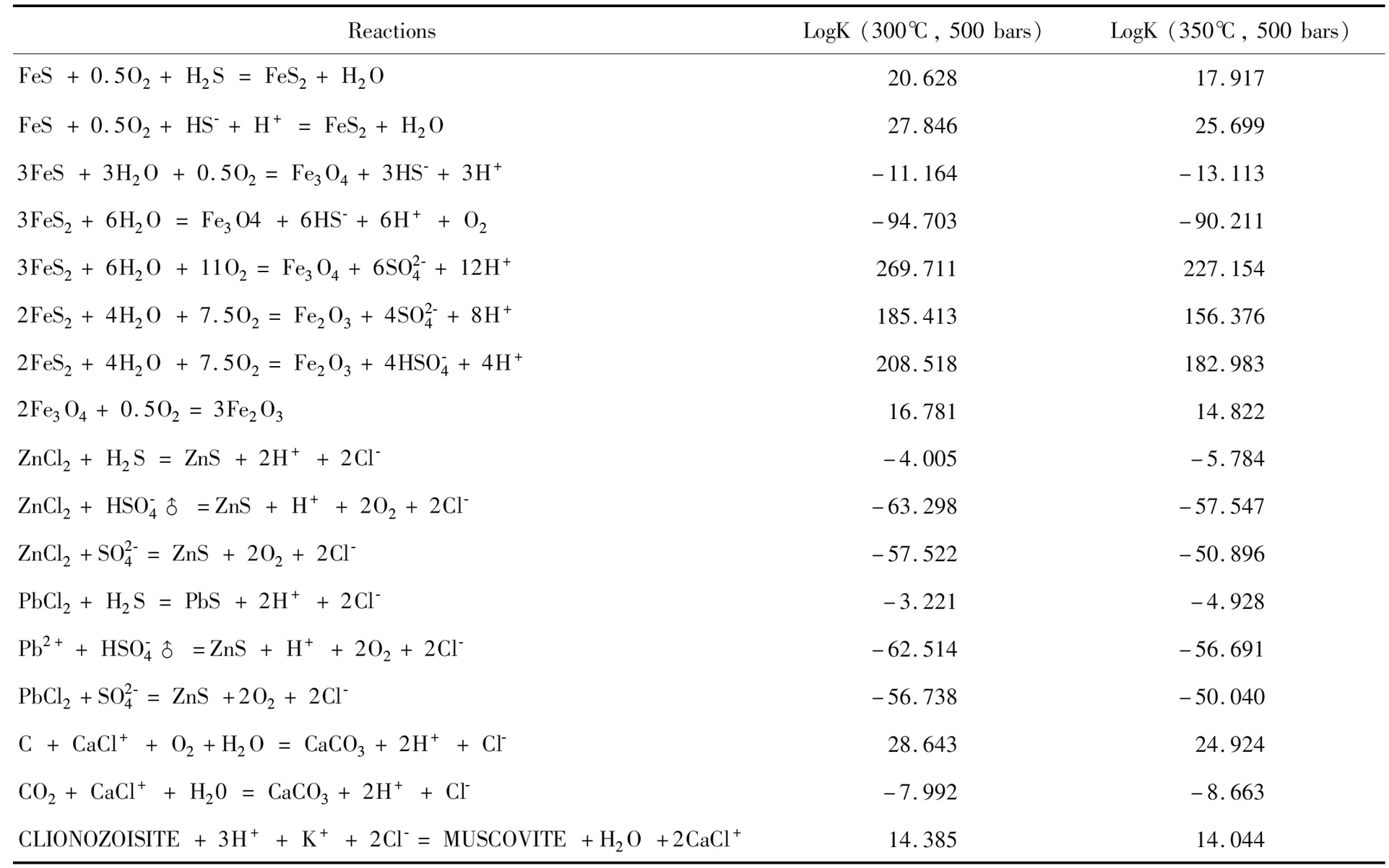
Table 1 Reactions and LogK values to constract thermodynamic model
5 Activity estimation
Shuetal. (2017) carried out detailed Laser Ablation ICP-MS studies of fluid inclusions and provided a set of reliable major and trace elements analysis results (Table 2). A large number of ratios and trend studies demonstrated the fluid source and evolution in the Baiyinuo’er skarn deposit. In particular, Pb and Zn concentration decreased from ~800 ppm to ~100 ppm during the cooling process (Fig.5). More than 80% of the fluid metal content precipitated in the syn-ore stage, which can be explained roughly by the gentler cooling and mixing with groundwater (Yuetal., 2015; Shuetal., 2013, 2017). But this explanation is unsatisfactory. In this process, too many parameters were changed, and it was difficult to determine that all changes were conducive to mineralization. The key is to clarify the changes of each parameter, especially the activity of important aqueous species.
In this section, we use Program GEMS to calculate the activity of important aqueous species based on the extended Debye-Huekel model (Kuliketal., 2013; Wagneretal., 2012; Helgesonetal., 1981). The aqueous solution system is simplified to the Na-Ca-K-Pb-Zn-Cl-H-O balance system and charge balance system. Here, in order to ensure the feasibility of the calculation, appropriate Ca and Cl concentration adjustments are allowed. The adjustments have limited impacts on the calculation of activity and negligible influences on the subsequent evaluation of solubility and pH. The aqueous species activities of 8 samples were calculated based on fluid inclusion microthermometry and LA-ICP-MS study. The activity in the pre-ore stage is difficult to calculate because there is no model suitable for high salinity system. The partial results are shown in Table 2 and Fig.6.
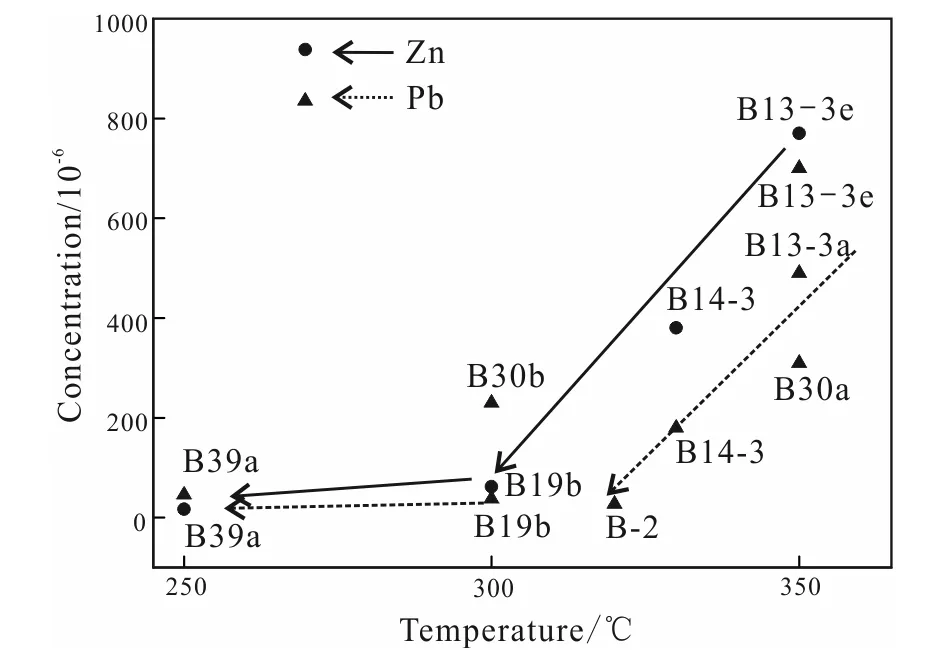
Fig.5 Trend diagram of important aqueous species concentrations with temperature (after Shu et al., 2017)

Fig.6 Trend diagram of important aqueous species with temperature
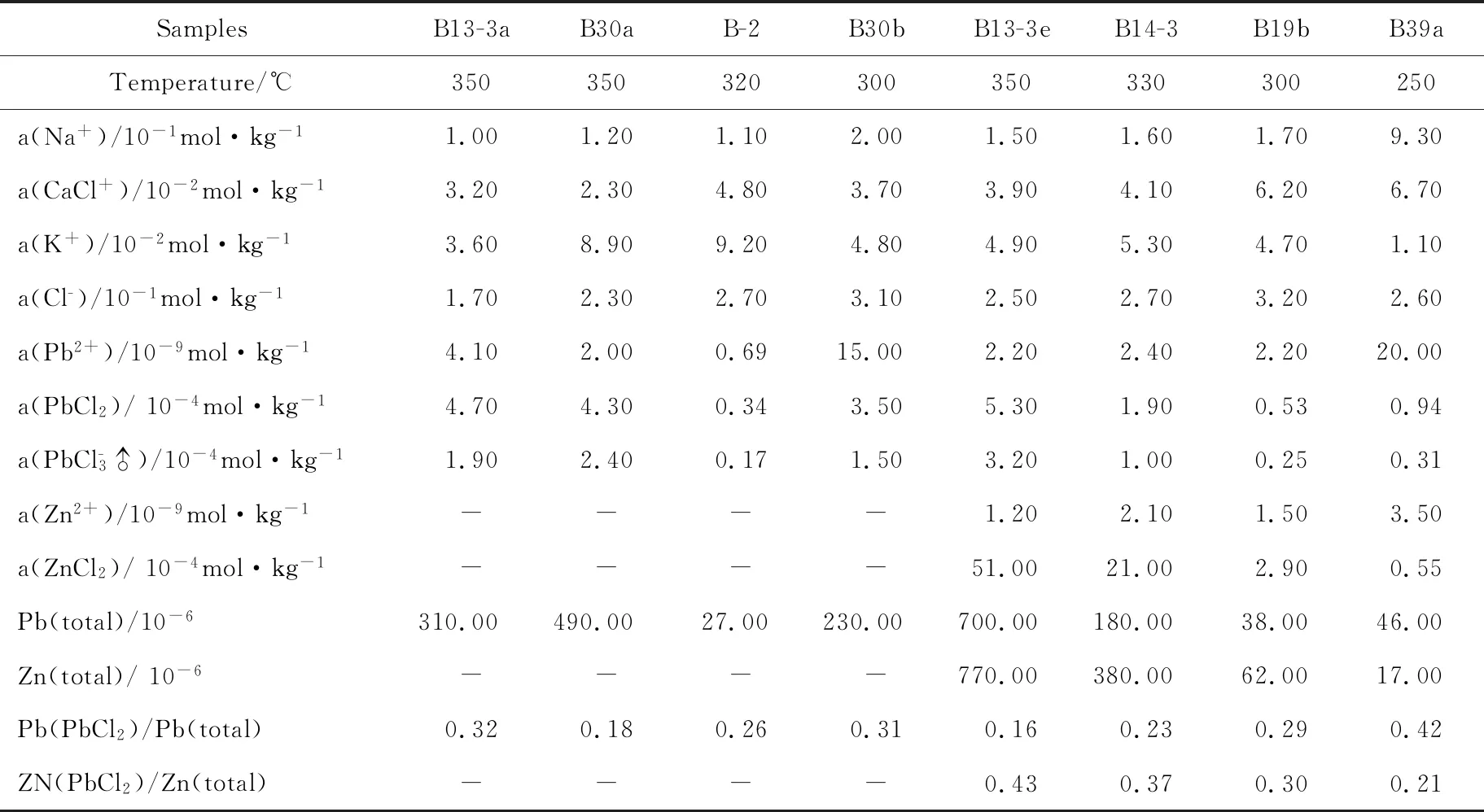
Table 2 Summary of estimated species activities
The samples B13-3e, B13-3a and B30a represent the early syn-ore stage. The value of a(PbCl2) was about 4.3×10-4to 5.3×10-4. The value of a(ZnCl2) was calculated as about 5.1×10-3. The values of a(Cl-), a(Na+), a(CaCl+) and a(K+) were approximately 0.17--0.25, 0.1--0.15, 0.023--0.039 and 0.036--0.089, respectively. The samples B30b and B19b represent the late syn-ore stage. The value of a(PbCl2) was about 3.5×10-4-5.3×10-5. The value of a(ZnCl2) was calculated as about 2.9×10-4. The values of a(Cl-), a(Na+), a(CaCl+) and a(K+) were about 0.31--0.32, 0.17--0.2, 0.037--0.062 and 0.047--0.048, respectively. The sample B39a represents the post-ore stage. The value of a(PbCl2) was about 9.4×10-5. The value of a(ZnCl2) was calculated as about 3.53×10-5. The values of a(Cl-), a(Na+), a(CaCl+) and a(K+) were about 0.26, 0.093, 0.067 and 0.011, respectively.

6 Discussion
pH, temperature and the activity of Cl-are considered to be important factors in the precipitation of minerals in hydrothermal deposits. Especially in skarn deposits, since acidic hydrothermal fluids react with marble, the increase of pH is taken for granted as the key to mineral precipitation. But there has never been a quantitative assessment, and this understanding is still conceptual. The estimation of activity makes it possible to evaluate the solubility of metal.
Based on reactions (1) and (2), Fig.7 was drawn to imply the solubility of Pb and Zn. All thermodynamic data are from the SUPCRT92 database (Johnson, 1992). Considering that the activity coefficient of XCl2is about 1, we chose XCl2as the aqueous species for evaluating solubility. In the activity calculation results, ZnCl2accounted for about 21% to 43% of the total Zn, and PbCl2accounted for about 15% to 42% of the total Pb, the Zn(ZnCl2)/Zn(total) was set as 0.33 and Pb(ZnCl2)/Pb(total) was set as 0.25 (Table 2). The activity of Cl-was set to 0.25 (Fig.7a, b), which was consistent with the calculation of the activity.
It shows that Pb and Zn could have deposited in response to: (1) an increase in pH; (2) a decrease in temperature; (3) a decrease in the activity of Cl-.
When pH=4 and a(Cl-)=0.25, the solubility of the metal may exceed 105ppm at 450℃. This value greatly exceeds the Pb and Zn concentration (Zn: 5 230--13 200 ppm; Pb: 9 450--19 000 ppm) in the pre-ore stage fluid based on LA-ICP-MS analysis for fluid inclusions trapped in pyroxene (Shuetal., 2017). The effect of temperature on solubility is huge. In the pre-ore stage, the high temperature makes metal precipitation impossible in the Baiyinnuo’er deposit. In addition, high salinity would provide more Cl-to form metal chlorides and inhibit the precipitation reaction. This means the solubility may be higher and the mineralization could not occur in the pre-ore stage.
Intense mineralization occured in the syn-ore stage and the temperature dropped to 300℃--370℃. On one hand, the solubility of Zn and Pb is more ea-sily to be controlled by the changes in pH and temperature than the change in the activity of Cl-in mineralization process, because the fluid salinity is difficult to reduce by orders of magnitude. The LA-ICP-MS results showed that the solubility of Zn and Pb decreased from ~800 ppm at 350℃ to ~100 ppm at 300℃(Shuetal., 2017). It seems that a further increase in pH is not required in this process to satisfy the solubility change (Fig.7a). Therefore, the effect of pH may be overestimated during 80% of the mine-ral precipitation process. On the other hand, previous studies on H-O isotopes and fluid inclusions have shown that the mixing between the high salinity magma water and the low salinity groundwater or meteoric water in Baiyinnuo’er deposit led to the decrease of the fluid salinity (Yuetal., 2015; Shuetal., 2017). Therefore, the activity of Cl-was presumably lower. In our activity calculations, the activity of Cl-did not decrease as expected, but rather showed an upward trend (Fig.6b). In fact, the change in temperature is also an important parameter affecting a(Cl-), more than the limited change in salinity does. Anyway, the change of a(Cl-) in Baiyinnuo’er deposit had a negative effect on mineral precipitation (Fig.7c).

(a) Solubility of Pb and Zn as a function of temperature; (b) solubility of Pb and Zn as a function of pH; (c) solubility of Pb and Zn as a function of a(Cl-). Fig.7 Trend diagram in solubility of Pb and Zn affected by different factors
When the temperature drops to 250℃, the estimated solubility is ~1 ppm (Fig.7), which is much lower than the true solubility (10--50 ppm) (Shuetal., 2017). Although lower pH means higher solubility, the decrease of pH is unlikely to be the cause of poor metal sulfide in the post-ore stage, because a large amount of precipitated calcite means a higher pH. The only reasonable explanation is that the S-rich fluid was converted to S-depleted fluid after under-going intense mineralization. At the same time, mixing with a large amount of meteoric water or groundwater could also cause a further drop in S concentration.
Based on the activity calculation results, a new and more accurate logfO2-pH diagram is constructed. The clear transition of the ore-forming environment is marked in the figure, and the metallogenic environment is roughly changed from X to Y in syn-ore stage (Fig.8). pH decreases from 4.0 to 3.7. It can be explained by equations (1) and (2). Metal precipitation was accompanied by the production of H+, and large fluid flux made H+incompletely consumed by marble. This acidic transformation did not deny the important role of marble in mineralization. It is just to expose the leading role of temperature. The consumption of H+by marble can prevent the fluid from becoming more acidic. But this still demonstrates our discussion that in the Baiyinnuo’er skarn deposit, pH is significantly overestimated, and it even inhibits mineralization.

(a) logfO2-pH diagram constructed at 350℃, 500 bars, a(S)=0.1 and a(C)=0.1; (b) logfO2-pH diagram constructed at 300℃ and 500 bars , a(S)=0.1 and a(C)=0.1. Total aqueous S and C activities were set to 0.1. These estimates are consistent with previous estimates in porphyry fluids (Hezarkhani et al., 1999; Barnes, 1979). The activities of aqueous species (K+, CaCl+, Cl-, PbCl2 and ZnCl2) used in Fig.8a,b were obtained from calculation results of Sample B13-3e and B19b, respectively.Fig.8 logfO2-pH diagram showing inferred conditions (shaded areas) for early syn-ore stage
7 Conclusions
(1) In the syn-ore stage, thefO2decreased from about -33.834 to -39.256, pH decreased from about 4.0 to 3.7 and the Cl-activity increased from about 0.25 to 0.3 during the cooling process (350℃ to 300℃).
(2) In Baiyinnuo’er skarn deposit, the dominant factor of mineralization was temperature, not the combination of pH, a(Cl-) andfO2as previously believed. The effect of pH may be overestimated in skarn deposit.
(3) Even in the skarn stage, the factor making the metal solubility >105ppm was the high temperature. A significant increase in pH only occurred in response to the production of large amounts of calcite in the post-ore stage.
杂志排行
Global Geology的其它文章
- Determining water well sites based on electrical structure in Taobei District of Baicheng
- Structure analysis of shale and prediction of shear wave velocity based on petrophysical model and neural network
- Influence of wettability of shaly sandstone on rock electricity parameters
- U-Pb-Hf isotopes of Neoarchean Shuimowan tonalites in southern margin of North China Craton: constraints on petrogenesis
- Spatial pattern analysis of forest landscape in Changbai Mountain
- Method for extracting angle-domain common image gathers in Kirchhoff beam migration
